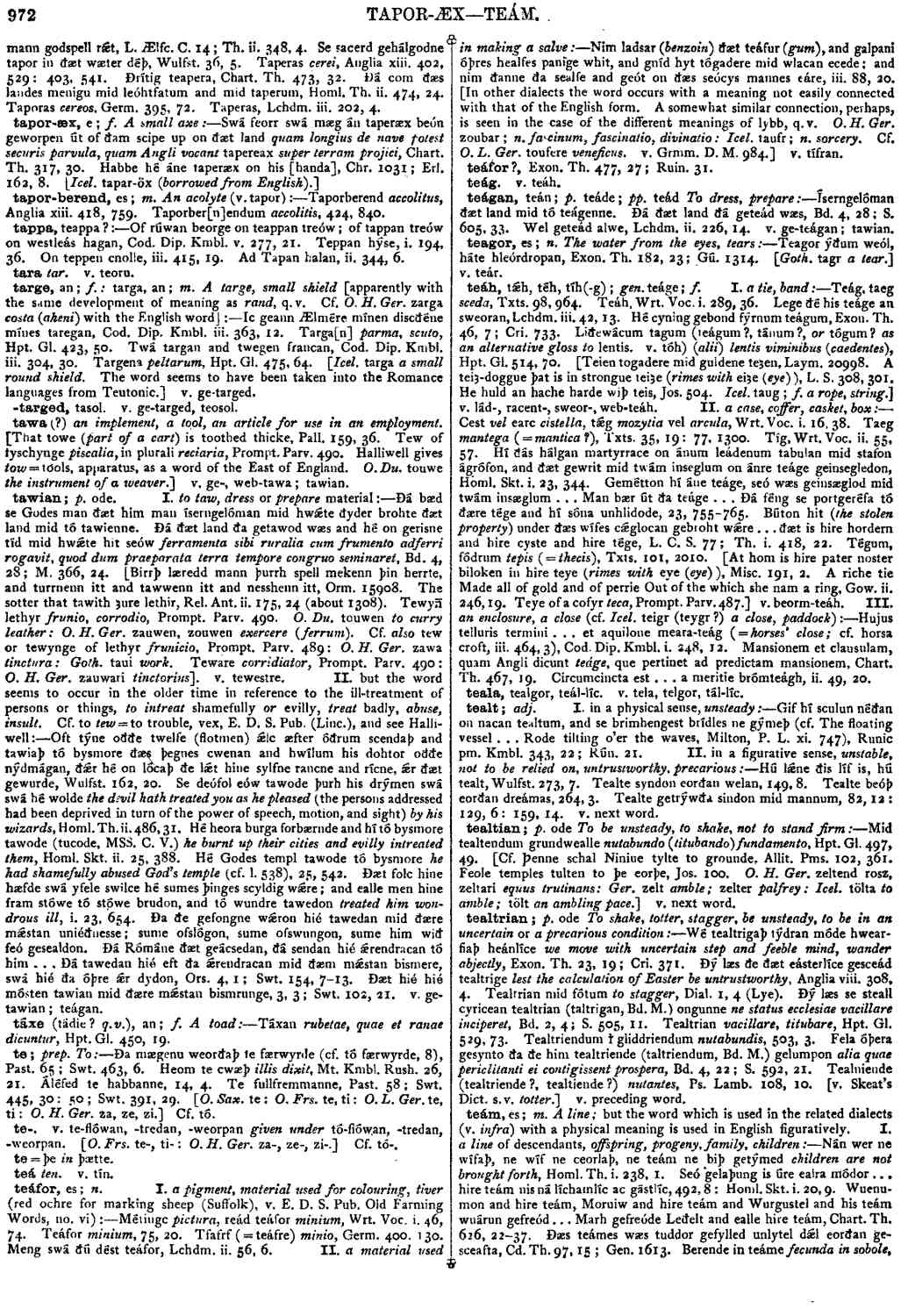teám
- noun [ masculine ]
-
Nán wen ne wífaþ, ne wíf ne ceorlaþ, ne teám ne biþ getýmed
children are not brought forth,
- Homl. Th. i. 238, 1.
-
Seó gelaþung is úre ealra módor ... hire teám nis ná líchamlíc ac gástlíc,
- 492, 8: Homl. Skt. i. 20, 9.
-
Wuenumon and hire teám, Moruiw and hire teám and Wurgustel and his teám wuárun gefreód ... Marh gefreóde Leðelt and ealle hire teám,
- Chart. Th. 626, 22-37.
-
Ðæs teámes wæs tuddor gefylled unlytel dǽl eorðan gesceafta,
- Cd. Th. 97, 15;
- Gen. 1613.
-
Berende in teáme
fecunda in sobole,
- Rtl. 110, 7.
-
Hé Noe bearh and his wífe and his teáme,
- Gen. 5, 31 note: Homl. Skt. i. 8, 18.
-
Caines ofspring forwearð ádrenced on ðam deópan flóde ... and of ðam yfelan teáme ne com nán þing siððan,
- Ælfc. T. Grn. 3, 27.
-
Séd ł teám
semen,
- Mk. Skt. Lind. 12, 21, 22.
-
Ðæt folc týmde micelne teám on ðam wéstene,
- Homl. Th. ii. 212, 17.
-
Teám gestrýnan,
- 324, 11.
-
Ðreó wíteþeówe men mé salde bisceop and hire teám,
- Chart. Th. 152, 22.
-
Fyllaþ eówre fromcynne foldan sceátas, teámum and túdre,
- Cd. Th. 92, 27;
- Gen. 1535.
-
¶ of animals :--Beón týmaþ heora teám mid clǽnnysse,
- Homl. Th. ii. 10, 17.
- Jul. 61, 7.
-
Drauh togedere al þene team under þe moder,
- A. R. 336, 15.
-
Wurrþenn wiþþ childe, and tæmenn hire tæm,
- Orm. 2415.
-
Ys foure sones ... Þys was a stalwarde tem,
- R. Glouc. 261, 4.
-
:-- Ðonne wíf byþ teámes ætealdod,
- Homl. Ass. 20, 159.
-
His wíf wearð mid Esau and Iacob, and heó geswác ðá teámes,
- 38, 339.
- O. E. Homl. ii. 133, 32.
-
Oxa on ðam forman teáme (cf. oxa on frumteáme imus, ii. 48, 36) imus, on ðam æfteran teáme
binus (bimus),
- Wrt. Voc. i. 23, 47, 48.
-
On ðæm æftran teáme
bimus,
ii.- 12, 70.
- 266, 11.
Bosworth, Joseph. “teám.” In An Anglo-Saxon Dictionary Online, edited by Thomas Northcote Toller, Christ Sean, and Ondřej Tichy. Prague: Faculty of Arts, Charles University, 2014. https://bosworthtoller.com/30238.
Checked: 1